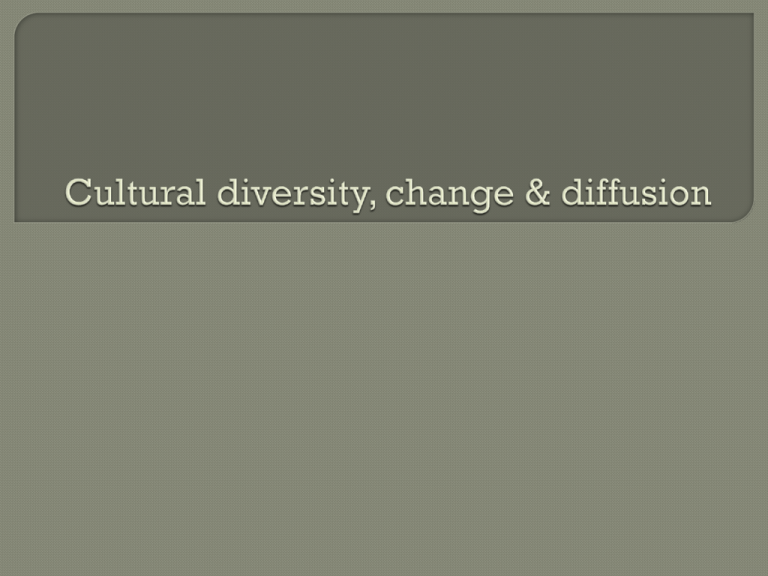Cultural Change
advertisement

Cultural Diversity refers to the wide range of cultural differences (symbols, values, language, norms) found between and within nations. Variation may be the result of natural circumstances (climate, geography) or social circumstances (level of technology and composition of population). 1. Examine the readings describing unique cultural practices around the world. 2. Then as a group we will discuss the following: a. Identify the cultural component. b. Describe its role in the culture. How does it shape peoples behaviour? c. How does this cultural component make the culture different from our Canadian cultural experiences? Homogenous societies – people share a common culture and are from similar social, religious, political and economic backgrounds. • Ex Sweden Heterogeneous societies – people are dissimilar in regard to social characteristics such as nationality, race, ethnicity, class, occupation, education. • Ex. Canada Immigration contributes to diversity in a society Over the past 150 years, more than 13 million (legal) immigrants have come to Canada (see fig 3.1, page 84) Canada has become a complex and diverse society and has produced subcultures Complete “Canadian Subcultures” reading and questions Hutterites and Skinheads Culture Shock is the disorientation that people feel when they encounter cultures radically different from their own Read Has about the Yanamamo tribe (pg 87) anyone else experienced culture shock? Ethnocentrism is the tendency to regard one’s own culture and group as the standard, and thus superior, whereas all other groups are seen as inferior. • Driving on the left side of the road in England is the “wrong side” of the road and driving on the right side in Canada is the “correct” side of the road. • A Westerner thinking that using chopsticks at every meal to eat is strange, silly, or a "stupid" way to eat A Canadian making jokes about the Korean practice of eating dogs. • One of the most well known and the most horrible examples of ethnocentrism to ever occur was during Nazi Germany. Adolf Hitler decided that he hated Jews, as well as some other groups of people, and had many innocent people slaughtered in concentration camps. They did not deserve the torture that they received, and this was clearly an extreme case of ethnocentrism. Please complete the Ethnocentrism Activity that you are being given! Use the internet to find your second example. Cultural Relativism is the belief that the behaviours and customs of any culture must be viewed and analyzed by the culture’s own standards Examples: • In India, cattle are viewed as sacred and are not eaten. In India there is also widespread hunger. From an ethnocentric viewpoint, we would conclude that cow worship is the cause of hunger and poverty in India. However, the Hindu taboo against killing cattle is very important to their economic system. Live cows are more valuable than dead ones because they have more important uses than as a direct source of food. As part of the ecological system, cows consume grass of little value to humans. Then they produce two very valuable resources – oxen (the neutered offspring of the cows)to power the plows and manure (for fuel and fertilizer) as well as milk. Culture should be viewed from the standpoint of those who live in a particular society. It may be used to excuse customs and behaviour (such as cannibalism) that may violate human rights. http://www.youtube.com/watch?v=Pmvt bnXBoCQ Cultural Diffusion – is the transmission of cultural items or social practices from one group or society to another. Non-material examples brought into Canada/US The Spanish Bull Run Comes to Virginia http://www.youtube.com/watch?v=ByZZtXOQ2lY The traditional HAKA Dance • • (http://www.youtube.com/watch?v=c-lrE2JcO44) (http://www.youtube.com/watch?v=uHW1K2LeQXE&feature=related) Material examples • • • piñatas tea cuisine It is attributed to three factors, transportation, technology, and better education. Because all three of those things are on the rise, cultures diffuse more and more each day. Cultural diffusion can be separated into six groups, Social, Political, Religious, Intellectual, Technological, and Economic. This picture shows MacDonald's in Saudi Arabia MacDonald's is an American restaurant that has expanded to have locations in 119 countries. There are similar examples of this cultural diffusion in Canada, where it is easy to find ethnic restaurants that serve foreign food. This picture shows several world leaders gathered together Because of the technology and transportation advances in recent decades, world leaders are able to meet more often United Nations Conferences, G8, World Trade Organization, etc. This picture shows American Muslims. Many years ago, Islam was almost exclusively found in Africa and the Middle East. However, through cultural diffusion, Muslims are now found everywhere in the world, including North and South America, Asia, and Europe. Because of advances in transportation and education, Muslims are able to live wherever they want. This graph shows the rising literacy rates of Pakistan over the last several decades. Literacy is on the rise in developing countries because of cultural diffusion. The education systems of developed countries are starting to transfer to developing countries, resulting in higher literacy rates. Without cultural diffusion, it is unlikely that we would see this same rise in literacy. This picture shows Kygryz herders taking pictures with their cell phones. The Kygryz people live in the mountains of northeast Afghanistan, and are completely isolated from the rest of the world. However, the Kygryz herders do use cellphones to take pictures and play music (they are useless for communication because cellular service doesn't reach them). This is an example of cultural diffusion through technology, because this picture shows that even the most isolated people in the world still use cellphones. This map of international trading blocs Today's transportation means that it is not uncommon for products to be manufactured in many faraway countries. For instance, the shirt you are wearing was probably not manufactured in Canada, but somewhere in Asia. Because it is now common to use products that were manufactured all over the world, economics are very heavily affected by cultural diffusion. Read ”Cultural Diffusion or Cultural Confusion” handout. Viewpoint: Saudi Women should not drive • http://www.bbc.co.uk/news/world-middle-east-15123076 Cultures For do not remain static example: the evolution of technology has changed the material culture of society When change occurs in the material culture of society, nonmaterial must adapt Frequently this rate of change is uneven, resulting in a gap. This disparity is referred to as cultural lag – a gap between the technical development of a society and its moral and legal institutions The PC (material) and electronic coding have made it possible to create a unique health identifier for each person in Canada. It is possible to create a national data bank that includes everybody's medical records from birth to death. Using this identifier, health providers and insurance companies could rapidly transfer medical records around the globe and researchers could access unlimited data on people’s disease, test results and treatment. However, the availability of technology does not mean that it will be accepted by people who believe (non-material) that such a national bank would constitute invasion of privacy and could be easily abused by others.







